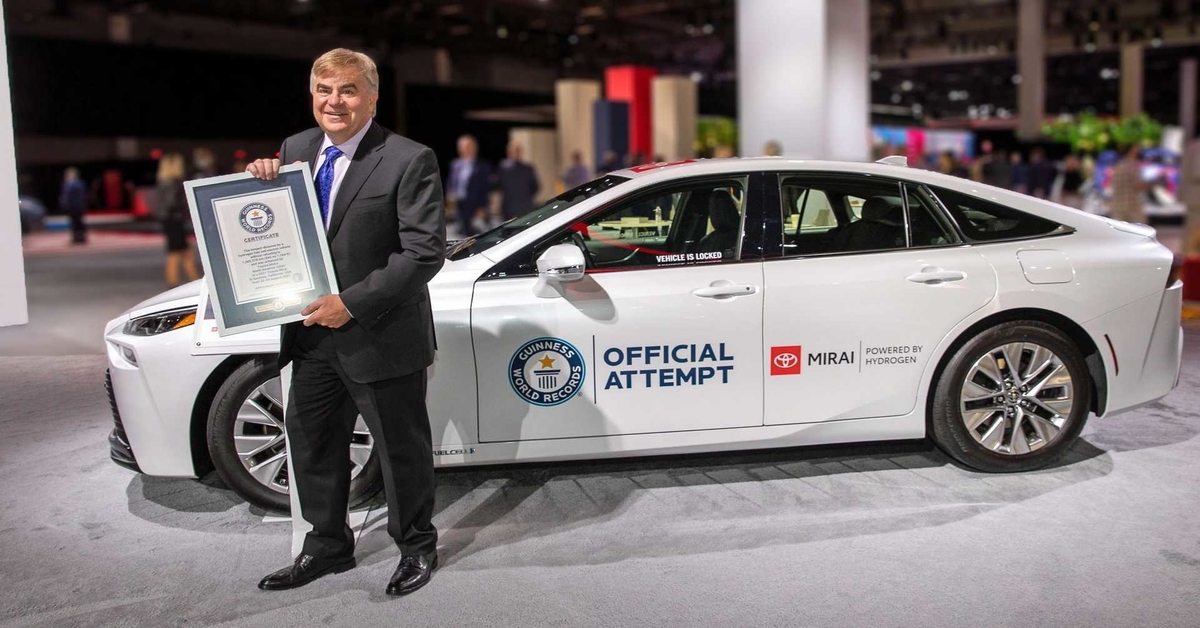The hydrogen-powered Toyota Mirai has just set a Guinness World Record for the longest distance travelled by a hydrogen fuel cell vehicle without refuelling.
A previous record was set in France in May by another Mirai, with a total distance of 1003 kilometres. Before that, another one was set with a Hyundai Nexo covering a distance of 887.5 kilometres between Melbourne and Broken Hill.
Clocking in 1360.378 kilometres (845 miles), this time the green vehicle completed a trip around Southern California, consuming a single tank of hydrogen fuel with a total mass of 5.65 kilograms. That’s the equivalent driving distance of Sydney to Adelaide!
Super light, but packed with energy.
But wait a minute – only 5.65 kilograms?! Is the car’s fuel tank that small?
Quite the contrary – the Mirai sports a combined fuel tank capacity of a whopping 122 litres. In comparison, the Toyota Camry has a fuel tank capacity of 72 litres.
The stark difference between the two boils down to molecular chemistry. The most abundant gas in the Universe, hydrogen gas is also the lightest. One litre of the gas weighs a mere 0.0896 grams – approximately 11 times lighter than the air we breathe.
Hydrogen also has the highest energy per mass of any fuel. But while hydrogen has nearly three times the energy content of gasoline (120 megajoules per kilogram vs 44 megajoules per kilogram), it has a much lower volumetric density compared to gasoline (8 megajoules per litre vs 32 megajoules per litre). That means a small mass of hydrogen will occupy a disproportionately huge amount of space.
To compress the hydrogen gas into its liquid form as fuel, you’ll also need immense amounts of pressure. And we’re talking about 700 times the atmospheric pressure! To withstand this skull-crushing pressure, the Mirai stores the compressed gas in hydrogen tanks made of super tough carbon-fibre-reinforced polymers.
Water-burping green machine.
Throughout the green car’s two-day journey, driven by two hypermilers, water was the only tailpipe emission.

In a fuel cell, hydrogen molecules are split into protons and electrons at the negative terminal of the cell, or the anode. Electrons flow through an external circuit, generating a flow of electricity that allows you to drive the car. Meanwhile, protons migrate through the electrolyte to the positive terminal, or cathode, where they unite with oxygen and electrons to produce water and heat.
But for the hydrogen car to be truly green, the production methods of the hydrogen fuel has to be sustainable, without any use of fossil fuels during hydrogen production. Green hydrogen is generated from the electrolysis of water, using energy from renewable sources such as wind and solar. During the process, water is split into hydrogen and oxygen – essentially the reverse of what occurs in the fuel cell of a hydrogen car. The resulting hydrogen and oxygen are then subsequently stored as fuel and for other applications.
Hydrogen, coupled with other green initiatives such as battery-powered electric vehicles and the large-scale deployment of renewable energy sources, could wean the world off its dependence on fossil fuels and aid the transition to net-zero.
Technological advances and brilliant innovations are making hydrogen production cheaper and more efficient. Together with governments’ commitment to decarbonise, the green hydrogen economy is no longer taking a back seat in driving humanity toward a climate-positive future.




































